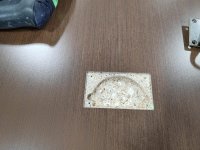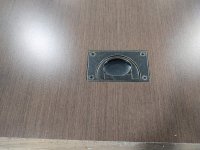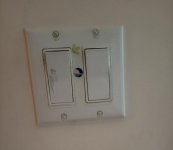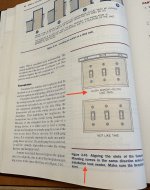I wrote this up in 2011:
https://www.inthewoodshop.com/Furniture/FittingHandles.html
Fitting Handles to the Military Chests
I spent a long time choosing the handles for these chests right at the start of the project, and then had to hunt around to find a decent quality in the size I wanted. The small size did restrict the choice – I just did not feel that anything larger would look right.
The handles all seem to be made in India these days, where they are cast in brass from the same molds. Finish seems to be a belt sander and then a polishing disk, with lacquer added at the end. The problem is that the handles all end up with dubbed edges and rounded faces. Every website around the world either uses the same publicity photograph, or they all end up looking the same.
I managed to find a supplier in Perth who had stocks from two manufacturers. One set of handles was dubbed and rounded over, and the other was dubbed but flat. I went for the dubbed but flat version.
After all this I was still unhappy with the handles. The edges were wavy (which would not look neat in a recess), and the shiny brass looked … well, too shiny. The inside edges of the pull were sharp enough to cut a finger.
So the first step was to fettle all the handles. This involved removing the protective lacquer – I plan to let the brass age naturally – flattening the top and smoothing the pull with 800 grit wet-and-dry followed by #0000 steel wool, and finally squaring the ends with a file.
Fettled and Original …
Templates
A template is needed to position the handles on the drawer fronts, and another is needed to outline the recess for each handle.
The template for positioning was made with a sheet of copy paper …
The position was traced in with a pencil.
… while a template for the recess was shaped in MDF to reflect the shape at the rear of the handle …
The combination of the two above produced this …
Handle morticing
The inner recess was excavated freehand with a router.
I discovered another use for Blue Tape!!!!
Trying to mark out the outline of each handle on the dark Jarrah with a knife created a line that was impossible to see. The knife would wander with the grain, and when it came time to chisel to the line, the wood would splinter and tear away.
Using Blue Tape not only aided in seeing the outline clearly, but it held the wood fibres securely while they were chiseled.
In the picture below a square is used to ensure each handle is positioned squarely and exactly at the same distance from the end of the drawer front …
Now mark the sides with a knife …
Here you can see (on the left) that I correct a marking. No matter – this will be removed along with the waste.
The waste is removed with a router, again freehand, and as close to the lines as I dare go.
The remaining waste is removed with a wide chisel.
Once this is done, recesses are required for the hinge bar on each side, and a little extra depth was created with a gouge for the domed rear …
The result …
…. Don’t forget to clock the screws.

Today ... the two military chests used as a TV stand ..

Regards from Perth
Derek



















